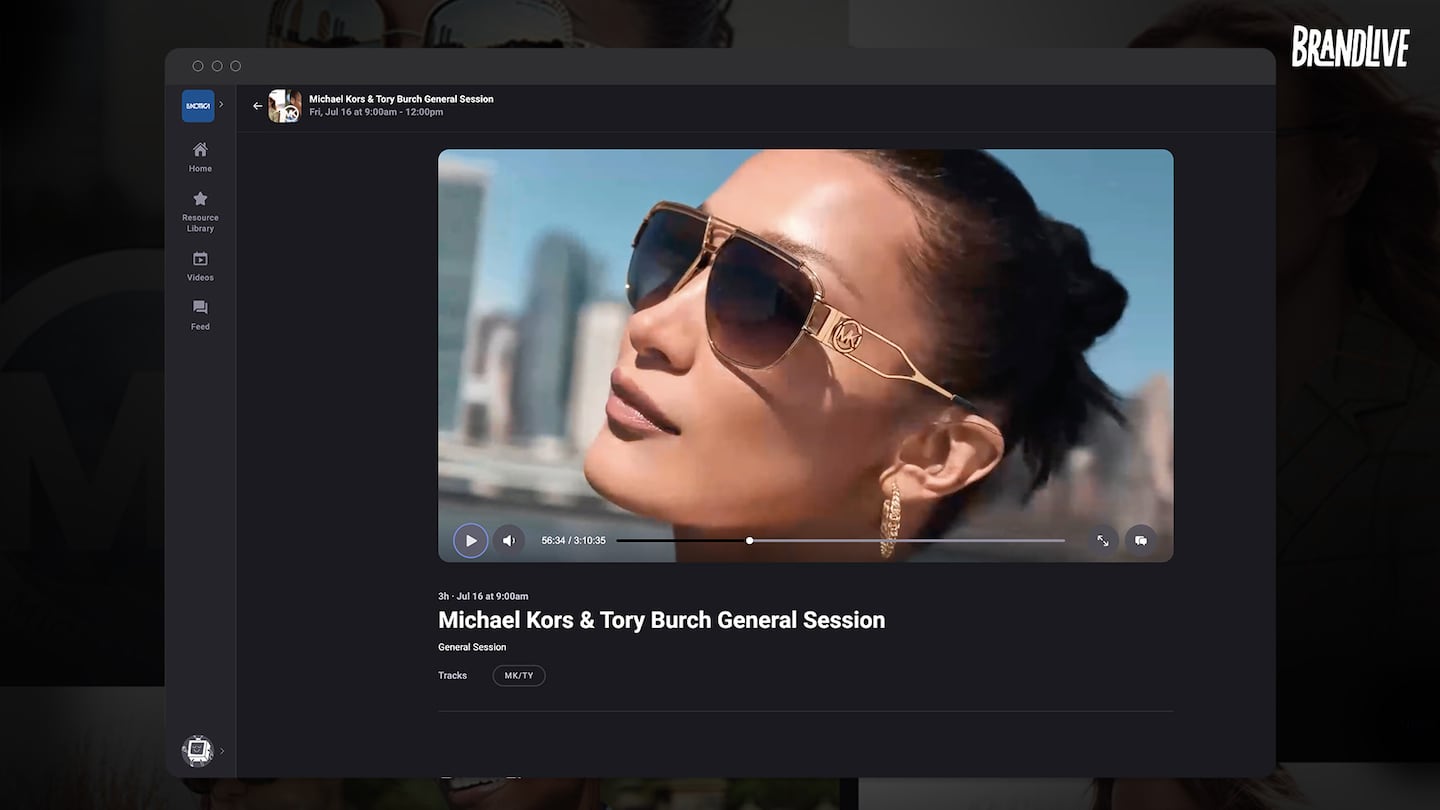
The Business of Fashion
Agenda-setting intelligence, analysis and advice for the global fashion community.

Agenda-setting intelligence, analysis and advice for the global fashion community.

Last year, digital live events company Brandlive and sportswear giant Nike co-developed Showrooms — a seasonal go-to-market and product education platform, taking physical elements of a showroom, such as “printouts, presentations and a three-ring binder, and turning it into an immersive, interactive, digital experience,” as Brandlive president and CEO Sam Kolbert-Hyle shared with BoF last year.
The first iteration of the platform hosted Nike’s latest product launches, distributed internally to employees and with key brand partners to educate their stakeholders on Nike’s upcoming seasons — at any time, from any location. Today, multi-billion dollar businesses and key industry players including Adidas, Patagonia, VF Corp and Luxottica are Showroom users. The product is tailored to each business, allowing for virtual contact sheets, product catalogues, Q&A feedback and training sessions in one virtual space.
Having delivered more than 50,000 digital events for partners since 2020, Brandlive works with its partners to provide digital solutions to their specific business needs, whether supporting internal company-wide meetings, hosting Hollywood-style productions for live streaming events, or by creating an educational content “hub” of product content in the Showroom.
Now, BoF speaks with Brandlive’s chief product officer, Thomas Iwasaki, to discover what drives success for brands using virtual showrooms and the company’s plans for the future.

What opportunity do you perceive in the digital showroom space?
The brands that are winning right now have acknowledged a need to transition the way they communicate — to become content and digital first, even to their B2B and internal audiences.
Realistically, the overhead of producing a video and distributing it is much lower and quicker than getting everybody to the same physical location for a few days. For example, Patagonia moved a press event onto Brandlive, sharing with us an original invite list of about 100 individuals. That invite list ended up increasing to 1,200 individuals, and once they uploaded their 20 videos onto the platform, we saw about 75 percent viewership of the content from that invite list.
Digital showrooms are for brands that are leaning into and embracing an always-on virtual mindset, where they can host key partners and salespeople or distributors in that go-to-market world. This not only increases reach and engagement, but also reduces the cost and environmental impact of travelling to a physical showroom space.
What are your brand partners looking for in a digital showroom product?
Initially, our partners wanted to share their go-to-market kick-off meetings in a virtual format, and they were focused on putting meetings from conference rooms online. The status quo is Zoom and web conferencing, but it’s hard to get a high impact story across in this format, especially if your audience can’t make a set meeting time. Few people will re-watch a recorded Zoom call.
Digital showrooms are for brands that are leaning into and embracing an always-on virtual mindset.
As a result, we evolved the Showroom product to reflect Netflix-style content drops and chat rooms, with product catalogues and Q&A functions to give brands the opportunity to produce more high quality content for internal and partner audiences.
What form of content do audiences engage with best?
It’s content with higher production value than a Zoom call and often shorter form. That doesn’t need to sound intimidating — it just means brands need to do some prep work. So, something with a bit of brand material, with a narrative, perhaps produced with some music and points of visual interest.
We see a lot of examples where brands upload their kick-off meeting into the platform, and it’s a 75-minute web conferencing recording and, sure, people click on — but they drop off or put it in the background. A highly produced hour of video or a series of five to 10-minute videos tends to see a lot more engagement.
So, in addition to the Showroom platform where you host your audience, our Greenroom content creation tool helps our partners turn what would have been a Zoom meeting into an engaging, episode-style video. It’s about taking the principles of content creation and storytelling that are used in a marketing sense and turning those inward.
How have consumption habits evolved content?
We have moved from mostly “live” to mostly “on-demand” as brands are thinking more about content as a series for their employees and stakeholders, dropping video content when they want to encourage engagement that lasts a longer period of time versus packing it all into the day-long agenda.
For example, a brand like Nike may drop 20 videos at the beginning of the season, punctuated with a live kick-off event to bring people together, but designed for asynchronous consumption so it feels more like Netflix than Zoom. This meets the consumption behaviour that viewers are used to — and they are excited to have highly produced content that’s available exclusively to them, all the time.
It’s about taking the principles of content creation and storytelling that are used in a marketing sense and turning those inward.
We now have a Q&A feed that spans the Showroom experience on each individual session, on every video page and product page, which is visible to all guests. This allows for audience interaction, so they can ask a question and receive a response that everybody can benefit from. Brands then have a central dashboard to see all of that engagement come in and ensure everybody feels heard and gets a response.
What are the key metrics of success brands look for today?
The number we talk about the most is “reach.” Previously, there was no real baseline of engagement to play against pre-pandemic because it was in-person. Now, as Showroom is an invite-only environment, brands receive insight down to the user-level, so they can understand who has attended, which content they have engaged with, when they engaged with it and how much time they’ve spent with the content.

The points of interest for brands are along two lines — firstly, it is which folks have engaged and which folks do we need to spend some extra time with or tailor communications to. There’s a lot of interest in the user-level engagement and the developing communication strategies around that knowledge.
Secondly, it’s which pieces of content are people getting excited about. If I look at the viewership retention chart of videos in a library, some will inevitably do better than others and you can understand right away which ones are performing well from a viewer retention standpoint, so brands can understand how to improve their content.
How do you boost engagement?
Brands are currently asking for ideas around gamifying the experience. It’s a great buzzword but we want to ensure we do this correctly, so we haven’t jumped out of the gate with some badging system or point scoring. We work with a lot of higher-end brands, so it’s got to be done right. We think that there is a big opportunity to create the idea of status through elements of gamification, and we’re pushing the envelope with some brands by creating game-like 3D spaces to add more fun to these experiences.
We are also developing notifications and emails that alert people to new content, letting them know when there’s a new post or a conversation on a product that they have viewed. So, we’re building hooks to pull users back to the platform, through which brands can further their reach, accessibility and then viewership numbers.
We will then be measuring productivity reporting straight from the sales and go-to-market product process, to understand the quality of education — meaning, how well do folks who engage actually understand the material. So, we’ll be building on top of the raw engagement data to understand the overarching impact downstream.
This is a sponsored feature paid for by Brandlive as part of a BoF partnership.
The nature of livestream transactions makes it hard to identify and weed out counterfeits and fakes despite growth of new technologies aimed at detecting infringement.
The extraordinary expectations placed on the technology have set it up for the inevitable comedown. But that’s when the real work of seeing whether it can be truly transformative begins.
Successful social media acquisitions require keeping both talent and technology in place. Neither is likely to happen in a deal for the Chinese app, writes Dave Lee.
TikTok’s first time sponsoring the glitzy event comes just as the US effectively deemed the company a national security threat under its current ownership, raising complications for Condé Nast and the gala’s other organisers.